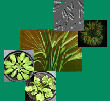| Lange, S; Bussmann, RW; Beck, E: Stand structure and regeneration of the subalpine Hagenia abyssinica forests of Mt. Kenya, Botania Acta, 110, 473-480 (1997), doi:10.1111/j.1438-8677.1997.tb00665.x | |
| Abstract: The uppermost forest belt on Mt. Kenya (Kenya, East Africa), ranges from 2900 to 3400 m a.s.l. and is dominated by the evergreen “Kosso” tree, Hagenia abyssinica (Bruce) J.F. Cmel. (Rosaceae). The ecology of this tree, with emphasis on regeneration, was investigated. Twenty‐five phytosociological relevés, representing several types of Hagenia forests were produced, and attributed to various associations of the alliances Hagenio abyssinicae — Hypericion revoluti Bussmann 1994 and Hagenio abyssinicae — Juniperion procerae Bussmann 1994 (Bussmann and Beck 1995a). Biometric data of young and adult Hagenia trees were collected. Kosso trees of the individual relevés were either of almost equal size, and presumably age, or could be grouped into only two size categories. This uniformity of the Hagenia populations suggests simultaneous regeneration after major disturbance. Charcoal horizons were found in soil profiles at various sites in the Hagenia zone of Mt. Kenya, indicating former burning of these forests. Therefore, fire is thought to be the disturbing factor, which triggers the regeneration of the Hagenia forests. Germination of Hagenia seeds was investigated under various ecological conditions at Mt. Kenya and in greenhouses. Crucial factors for successful germination were high temperatures and bare soil. Light intensity or potentially allelopathic decomposition compounds, leaching from the abundantly shed leaves, had no significant effect on the germination rates. Fire apparently promotes germination by clearing and heating the prospective seed bed. In areas suffering from a high activity of herbivores, the regeneration capability of Hagenia is greatly decreased or abolished. A fire‐requiring regeneration cycle of the Hagenia forests of Mt. Kenya is concluded from the phytosociological and ecological data. |

Letzte Änderung 06.07.2020

